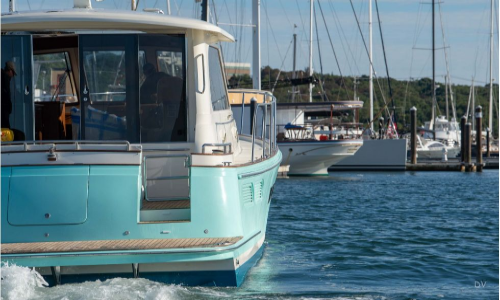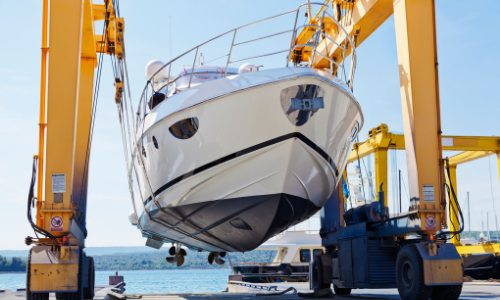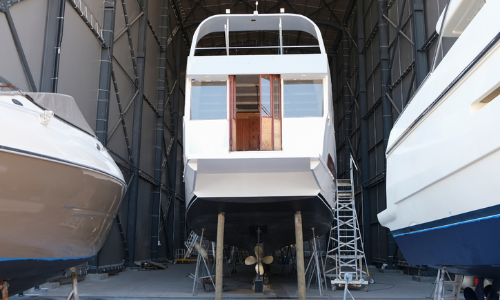
Dock Space Reservation Platforms
February 16, 2022
What to Look for in a Storage Facility
March 29, 2022How to De-winterize Your Boat for Spring
Experienced boaters understand the importance of proper seasonal boat maintenance. While preparing a watercraft for winter storage can be an arduous task, there’ll be a rewarding payoff when boating season begins again. However, you’ll need to properly de-winterize your vessel before getting back on the water when spring comes.
De-winterization Overview
As long as you took the right steps when winterizing your boat, de-winterizing it should be fairly simple. Never performed spring boat maintenance before? This article will help you:
- Understand why de-winterizing is important for all boat owners.
- Know when to de-winterize your vessel in the spring.
- Follow the steps to de-winterize a boat for a successful sailing season.
Why De-winterize?
Getting Your Boat Ready for Spring
Most boaters want to start cruising as soon as the weather warms up, especially those living in the Northeastern United States where boating season only lasts a few months. However, before you launch your vessel, you need to make sure that it’s still seaworthy after its long stay in winter storage.
De-winterizing your watercraft is essentially giving it a thorough once-over to ensure that all systems are functioning properly. If you notice any issues, including a dead battery, oil leak, broken water pump, stress cracks in the hull, or even chipped or faded paint, you can fix the problem before taking the boat out on the water.
How Much Does It Cost To De-winterize A Boat?
If you properly winterized your vessel during the off-season, the damages (and, therefore, the cost of repairs) should be minimal. However, it all depends on whether your watercraft sustained any damage during its time in storage. How you chose to store your yacht for the winter can also affect the cost of getting your boat ready for spring.
Both indoor and outdoor boat storage come with their own risks, ranging from scratches and mildew to freezing and corrosion. If you chose to keep your vessel at a boat storage facility, the company you picked might cover the costs for any damages that occurred while your craft was in their care. However, this usually only applies if the engine hasn’t run since the completion of the winterization process.
When you use a storage facility that offers winterization and de-winterization services, they usually include the cost of preparing your vessel in the contract. Boatyards and marinas may charge anywhere from $150 to $500 for these services, depending on the size of your boat.
Of course, de-winterization is likely to cost more if your boat needs extensive repairs or replacement for parts and systems. If the craft needs simpler, mostly cosmetic maintenance, you can save money by prepping the vessel yourself. Keep in mind, however, that tackling the process on your own will also include costs for items like shop vacuums, pressure washers, coolant, and oil additives.
Timing
When Should You De-winterize Your Boat?
De-winterizing your vessel before winter is well and truly over can expose your boat to engine damage from freezing, undoing all the hard work you did to prevent it during the winter season. On the other hand, if you wait too long, you’ll have fewer days on the water. You’ll need to time your de-winterization just right to ensure smooth sailing as soon as possible.
To know when to de-winterize your boat, you need to ask yourself, “When will the last spring freeze of this year happen?” Go to the NOAA’s website to see the average temperature trends in your region, find the last time temperatures hit 32 degrees Fahrenheit, and use that date as a marker for when to start the de-winterization process.
***
Although the NOAA depicts the 30-year average temperatures in each region, some areas of the U.S. may be too cold to get an accurate reading. Keep an eye on your local weather forecasts to ensure that you start the de-winterization process after the last spring freeze of the year.
***
Sailors who are excited to get the next boating season underway can complete a few small de-winterization tasks ahead of time. Take advantage of some of the warmer days of early spring and start prepping your watercraft by:
- Taking off the cover and cleaning the interior
- Bringing safety equipment, etiquette flags, and accessories back on board
- Inspecting the hull
- Checking the trailer for flat tires or burnt-out lights
- Looking for mast or rigging damage
- Inspecting sails for wear
- Ensuring your trailer and boat registration are current
- Obtaining this year’s trailer tags
- Updating your boat insurance policy if needed
***
Be sure to save all tasks that involve draining coolant, starting the engine, or using water for cleaning purposes until the full de-winterization process after the last spring freeze.
De-winterizing Guide
What is Involved in De-winterizing a Boat?
Use the following list as a guide to help you through the ten steps of de-winterizing your watercraft. Depending on the type of boat and motor you have, the process may take longer for you than it does for others. Try to set aside a weekend or two during the early spring to perform all the necessary tasks so you can get boating season off to a quick and successful start.
1. Clean & Inspect for Damages
Take Off the Cover
Start by carefully removing the shrink wrap, tarp, or covering from your boat. If you have a canvas cover, inspect it for tears and signs of leakage to determine whether you need to repair or replace it before the next winter.
Check for Signs of Rodents and Pests
Search the covering and interior of the boat for signs of insects, birds, mice, and other pests. Check for scratches on the floorboards, gnawing marks on the wiring, nests inside the tarp, or droppings in the corners. If you notice any of these things, clear them out and make a note of them so you can secure the covering better when it’s time to winterize the boat again.
Clean the Interior and Exterior
Next, give the boat a thorough wipe down to eliminate dust, dirt, and grime. Along with helping your vessel look beautiful for its first spring voyage, cleaning the bow, stern, and everything in between is an efficient way to remove potential allergens and bacteria. It also gives you a chance to notice and fix any cosmetic issues like buffing out scratches, replacing wiper blades, or adding a fresh coat of paint.
***
Spring Cleaning Checklist for Boats
***
- Clean windows and fiberglass
- Vacuum soft surfaces like carpet, canvas, seat cushions, and vinyl
- Patch cracks and tears in seat cushions, then apply protective cleaners
- Wipe down the hull, inspecting for dings, scrapes, blisters, distortion, and cracks along the way
- Wait for the hull to dry, then apply a wax or polish
- Polish all exposed wood and metal parts
- Apply an oil finish to wood surfaces like teak to preserve the glow and quality of the wood
***
During this phase of the de-winterization process, you can sand the bottom of your watercraft if necessary, then use antifouling paint to restore the hull, keep it clean, and prevent rot.
***
2. Check the Engine & Oil
Giving your engine proper TLC is essential for both winterizing and summerizing a boat. You’ll need to inspect the motor for dents and other damages to learn whether it needs repairs or replacement. At this point, you should also change the oil and replace the filter. Remember to use the appropriate oil additive to avoid corrosion and keep your engine clean.
How Do You De-winterize An Outboard Motor?
Stern-drive and outboard engines require a little more attention than an inboard motor. Most of the maintenance involves making sure the engine is clean before starting it. To ensure that your outboard motor is in the best shape, you’ll need to:
- Inspect and replace any rubber outdrive bellows that are cracked, dried, or showing signs of deterioration.
- See if the steering is unnaturally stiff, then check the power steering fluid, cables, and power trim oil.
- Look for corrosion on the battery and replace anodes that are over a year old.
- Replace the control cables if the outer jacket is cracked or swelling.
- Top off lower unit oil of a sterndrive or outboard motor if needed.
3. Check & Refill the Cooling System
Inspect Hoses and Empty Strainer
Before you can refill the cooling system, you need to ensure that all the hoses are free of cracks and leaks, you can refill the cooling system. You should also empty and clean your raw water strainer or sea strainer at this stage in the de-winterization process. Make sure you do this after shutting off the water to avoid flooding the boat.
Flush and Refill
Ideally, you should flush your cooling system before putting your boat in storage. If you took this step during winterization, you can go ahead and refill the system with equal parts coolant and distilled water once you check the hoses and empty the strainer. Otherwise, you’ll have to flush and drain the system first.
Check the Impeller
Impellers on outboard motors pump cold water through the cooling lines to prevent the engine from overheating. You must replace the water pump on the impeller after 200 hours of use to keep the motor running properly. If you notice any cracks, you’ll need to get a new impeller. Check online for service kits to guide you through the repair and replacement processes.
Check the Thermostat
Along with regulating the temperature of the water, the thermostat keeps pressure in the cooling system and enables heat to transfer from the heads to the cylinder walls. Like with the water pump, you’ll need to replace the thermostat every 200 hours. Once you finish maintenance on the cooling system, you can connect the wires to the spark plugs.
4. Reconnect Battery
Many boaters put their boat battery on a trickle charger for the winter, then hook it back up in the spring. Take the battery off the charger and test the amps and volts to see if it can hold a charge. If the battery has gone bad, replace it. Otherwise, clean off any corrosion around the terminals, attach it to the cables, and top off your fluids so the battery is ready for the electronic systems check.
5. Clean the Distributor
Cleaning the distributor is an essential part of the de-winterization process, especially if you stored your boat outdoors or in a marina slip where water could have caused corrosion. Remove the cap, wipe out the inside of the unit, and scrape off any powdery residue. As an extra precaution, you can apply an anti-corrosion agent before tightly screwing the cap back on.
6. Check the Fuel System
Inspect for Leaks
A damaged fuel system can cause major problems for your boat’s engine, including misfires and RPM drops. During the de-winterization process, make sure there are no cracks, leaks, or softening in your boat’s fuel tank, pump, filter, fuel lines, and vent hoses. Check the non-combustible clips and straps in the support system as well to see if they’re broken or need replacing.
Refill Gas Tank & Change Filter
When you put your boat in storage, you should have used a fuel stabilizer in the gas tank to prevent phase separation. If you skipped this step during winterization, you’ll need to drain the tank and your portable gas caddies before refilling them with fresh fuel and a non-ethanol additive. Those who didn’t change the fuel filter during storage prep will also need to inspect, clean, or replace the filter.
7. Look for Worn Belts
A worn or broken belt can eventually damage your water pump and alternator, causing the engine to overheat. During your springtime boat inspection, press down on the belts to see if they’ve lost any slack. If they give easily or have traces of black soot on them, replace the belts immediately.
8. Attach Electronic Systems
Use the battery you charged and connected during step four to test your vessel’s electronic equipment and systems. Check your GPS, depth finders, lighting systems, signals, and speakers to make sure they’re all in working order. If your boat has an automatic bilge pump, switch the battery off and listen for the sound of the pump mechanisms working.
9. Inspect Bilge Pump
Whether or not you hear any unusual sounds from the bilge pump, you need to take a look at it to see if there are damages. Check the pump itself, the automatic float switch, and the circuit for signs of corrosion, breaks in the cables and wiring, or a burnt smell that indicates an internal short.
Clear away any debris preventing the float switch from working, and ensure nothing is jamming the impeller. Low battery voltage, the manual switch at the helm, and even kinked, disconnected, or blocked outlet hoses can affect your automatic bilge pump. If the pump is still faulty after checking all these components, contact a service technician to find the source of the problem.
10. Inspect the Trailer
Once your watercraft is in tip-top shape, you can wrap up the de-winterizing process by giving your boat trailer a final once-over. An unexpected flat tire or expired tags can delay your first day back on the water, so give your trailer a thorough inspection that includes:
- Checking the tires for dry rot, insufficient tread, and wear
- Making sure all tires have accurate pressure readings
- Servicing or replacing the wheel bearings along with new seals
- Checking surge brakes and changing them out as needed along with topping off brake fluid
- Verifying that all signals and trailer lights work properly
- Getting the appropriate strapping to secure the boat
- Inspecting the hitch chains and ensuring the hitch itself is good for travel
- Sanding and painting the trailer frame and axels to remove rust
***
Plan on taking your boat to another state? Depending on the size of your vessel, you may want to consider a marine transportation service to get you on the road and then back in the water safely.
***
Let the Season Begin
If you want to start enjoying your watercraft as soon as the weather warms up, proper spring boat maintenance is crucial. By following the necessary steps for de-winterizing your boat, you can ensure your vessel is at peak performance before embarking on your first voyage of the new season.


